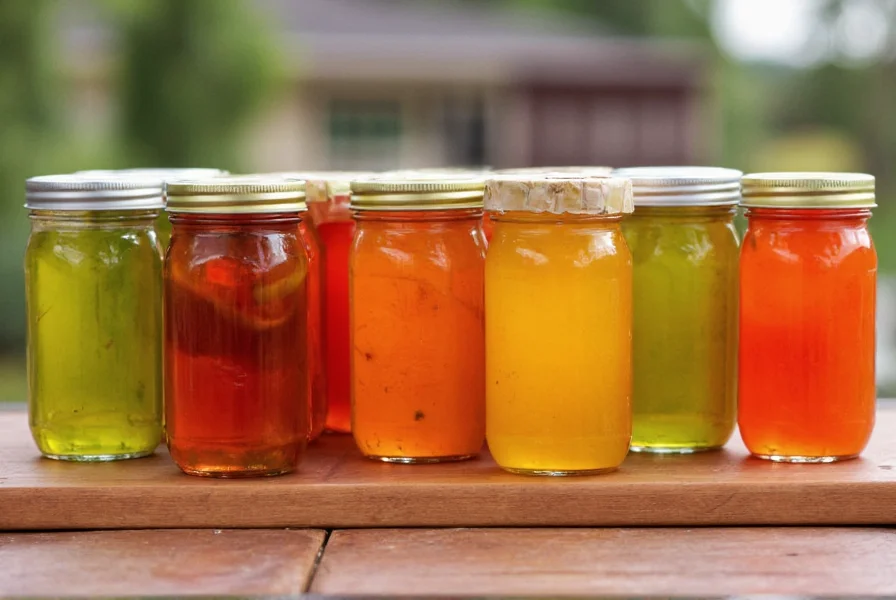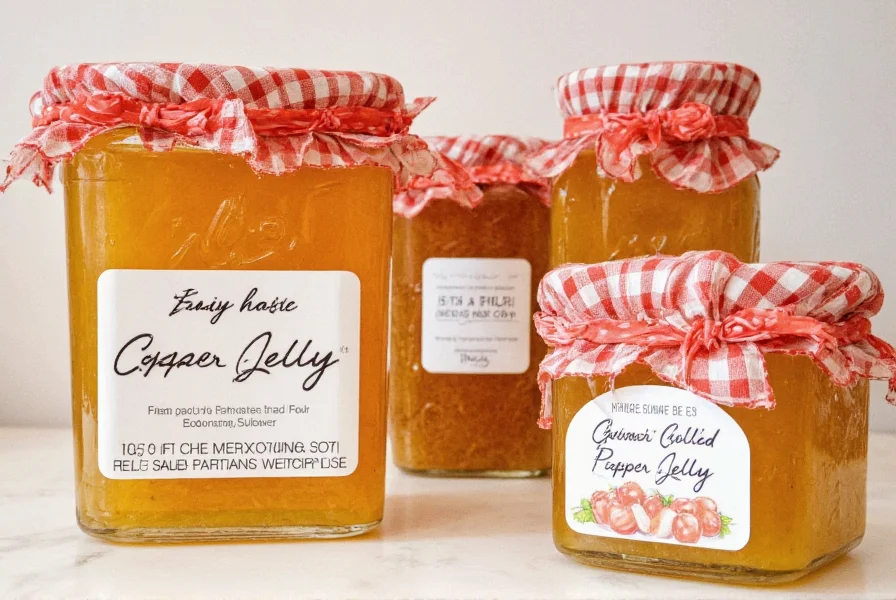Creating perfect pepper jelly at home combines culinary art with food science. This guide provides tested recipes, safety protocols, and creative variations that transform simple ingredients into a versatile condiment beloved by home cooks and professional chefs alike. Whether you're a beginner preserving your garden harvest or an experienced canner seeking new flavor combinations, these pepper jelly recipes deliver consistent results with proper technique.
Essential Equipment for Perfect Pepper Jelly
Before starting your pepper jelly journey, gather these essential tools:
- 8-10 quart stainless steel pot (avoid aluminum which reacts with acid)
- High-quality candy thermometer (200-220°F range)
- Canning funnel with wide opening
- Heat-resistant glass measuring cups
- Long-handled non-reactive spoon (stainless steel or silicone)
- Properly sized canning jars with new lids and bands
- Magnetic lid lifter and jar gripper
- Timer for precise cooking intervals
Understanding Pepper Jelly Ingredients
The magic of pepper jelly comes from balancing four key components. Each ingredient serves a specific purpose in texture, flavor, and preservation:
| Ingredient | Function | Recommended Amount |
|---|---|---|
| Fresh peppers | Provides heat and flavor complexity | 2-3 cups finely chopped |
| Granulated sugar | Preservative and texture contributor | 3-4 cups (varies by recipe) |
| Apple cider vinegar | Acidity for safety and flavor balance | 1½ cups |
| Pectin | Creates proper gel structure | 1 pouch (liquid) or 2 pouches (powder) |
Classic Jalapeño Pepper Jelly Recipe
This beginner-friendly recipe yields 6-8 half-pint jars of perfectly balanced sweet and spicy jelly. The key to success lies in precise measurements and proper canning technique.
Ingredients
- 3 cups finely chopped jalapeños (seeds removed for milder version)
- 1½ cups apple cider vinegar
- 4 cups granulated sugar
- 1 (1.75 oz) pouch liquid pectin
- ¼ teaspoon butter (reduces foaming)
Step-by-Step Instructions
- Prepare canning equipment: Wash jars in hot soapy water, keep warm in 180°F water bath. Heat lids in separate simmering water (180°F).
- Combine peppers and vinegar in large pot. Bring to boil, reduce heat, and simmer uncovered for 20 minutes.
- Stir in sugar and butter. Return to full rolling boil that cannot be stirred down.
- Add pectin all at once, stirring constantly. Return to full rolling boil for exactly 1 minute.
- Remove from heat. Skim foam if necessary.
- Using canning funnel, fill sterile jars leaving ¼-inch headspace.
- Wipe rims with clean damp cloth, apply lids and bands fingertip-tight.
- Process in boiling water bath for 10 minutes (adjust for altitude).
- Remove jars, cool undisturbed for 12-24 hours. Check seals before storing.
Popular Pepper Jelly Variations
Once you've mastered the basic technique, experiment with these delicious variations that showcase different flavor profiles while maintaining proper preservation standards.
Triple Pepper Medley Jelly
Combine 1 cup each of finely chopped red bell peppers, jalapeños, and serranos for complex flavor. Add 1 tablespoon lemon zest during final boil for brightness. This sweet and spicy pepper jelly variation creates a beautiful gradient when poured.
Habanero Mango Pepper Jelly
Substitute 1 cup chopped mango for some peppers in your basic recipe. The tropical fruit balances habanero heat with natural sweetness. Ideal for pairing with pork or fish. When making habanero pepper jelly recipes, wear gloves when handling peppers and avoid touching your face.
Smoky Chipotle Pepper Jelly
Use 2 cups finely chopped roasted red bell peppers and 1 cup minced chipotle peppers in adobo sauce. Add 1 teaspoon smoked paprika for depth. This smoky pepper jelly recipe pairs exceptionally well with grilled meats and barbecue.

Canning Safety Guidelines
Proper preservation ensures your homemade pepper jelly remains safe and shelf-stable. Follow these critical safety protocols for successful canning:
- Maintain proper acidity: pH must be below 4.6 for safe water bath canning
- Use tested recipes with precise vinegar-to-sugar ratios
- Always process in boiling water bath for recommended time
- Check seals before storage: lids should not flex when pressed
- Store in cool, dark place for up to 18 months
- Refrigerate after opening and use within 3 weeks
Troubleshooting Common Issues
Even experienced canners encounter challenges. Here's how to address frequent pepper jelly problems:
Jelly Won't Set
If your jelly remains too liquid after cooling, possible causes include:
- Insufficient pectin (follow package instructions precisely)
- Incorrect sugar measurement (use weight measurements for accuracy)
- Not reaching proper gel point (220°F at sea level)
- Over-dilution from excess pepper liquid
Solution: Re-cook with additional pectin following manufacturer's instructions.
Crystallization Issues
Crystals forming in your jelly typically indicate:
- Sugar not fully dissolved before boiling
- Improper cooling technique
- Contaminants introduced during processing
Prevention: Stir constantly while bringing to boil, use clean equipment, and avoid disturbing jelly during setting phase.
Serving Suggestions and Pairing Ideas
Pepper jelly's versatility makes it a kitchen staple. Try these creative serving ideas for your homemade pepper jelly recipes:
- Cheese boards: Pair with cream cheese, brie, or sharp cheddar
- Appetizers: Glaze baked brie or mix with cream cheese for pepper jelly pinwheels
- Meat glazes: Brush on chicken, pork, or salmon during last 5 minutes of cooking
- Cocktail mixer: Stir into margaritas or bloody marys for spicy twist
- Breakfast: Swirl into yogurt or spread on bagels with cream cheese
Storage and Shelf Life Guidelines
Properly processed pepper jelly maintains quality and safety when stored correctly:
- Unopened jars: Store in cool, dark place for 12-18 months
- Refrigerated after opening: Consume within 3 weeks
- Freezing: Not recommended as it alters texture
- Signs of spoilage: Mold, off-odors, or bulging lids indicate unsafe product
Conclusion
Mastering homemade pepper jelly recipes opens a world of flavor possibilities while preserving seasonal harvests. By following precise measurements, proper canning techniques, and safety guidelines, you'll create consistently delicious results that impress family and friends. The sweet and spicy balance of well-made pepper jelly enhances everything from simple appetizers to gourmet meals, making it one of the most versatile preserves you can create. Start with the basic recipe, then experiment with different peppers and flavor combinations to discover your signature creation.
Frequently Asked Questions
Can I make pepper jelly without pectin?
Yes, you can make pepper jelly without pectin by using high-pectin fruits like apples or citrus along with extended cooking time to reduce liquid. However, results may be less consistent, and processing time must remain the same for safety. The traditional method using commercial pectin provides more reliable texture and is recommended for beginners trying easy pepper jelly recipes for beginners.
How do I adjust heat level in pepper jelly recipes?
Control heat by adjusting pepper types and preparation. For milder jelly, remove all seeds and membranes from hot peppers. For medium heat, include some membranes. For extra spicy pepper jelly, add seeds or use hotter varieties like habaneros. Remember that heat intensifies slightly during cooking and mellowing period. Always wear gloves when handling hot peppers to avoid skin irritation.
Why did my pepper jelly crystallize?
Crystallization typically occurs when sugar hasn't fully dissolved before boiling or when the mixture cools too quickly. To prevent this, stir constantly while bringing the mixture to a boil, use clean equipment, and avoid disturbing the jelly during the setting phase. Using precise measurements and following tested canning pepper jelly step by step instructions minimizes crystallization risks.
How long does homemade pepper jelly last?
Properly processed and sealed homemade pepper jelly maintains quality for 12-18 months when stored in a cool, dark place. Once opened, refrigerate and consume within 3 weeks. Always check for signs of spoilage like mold, off-odors, or bulging lids before consuming. Following shelf-stable pepper jelly preservation guidelines ensures maximum freshness and safety.
Can I use different types of vinegar in pepper jelly?
Apple cider vinegar is preferred for its balanced acidity and flavor, but you can substitute white vinegar or rice vinegar in equal amounts. Avoid balsamic or wine vinegars as they alter both flavor and acidity levels critical for safe preservation. When experimenting with sweet and spicy pepper jelly variations, maintaining proper acidity (pH below 4.6) is essential for water bath canning safety.











 浙公网安备
33010002000092号
浙公网安备
33010002000092号 浙B2-20120091-4
浙B2-20120091-4